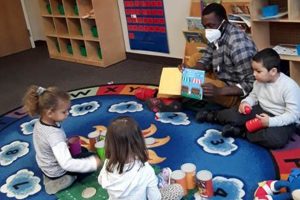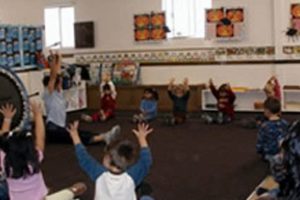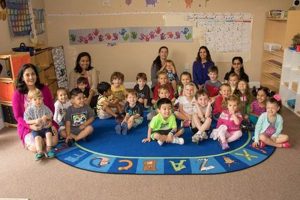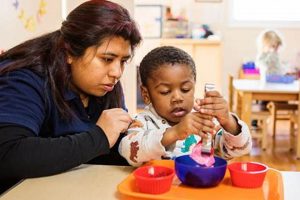Musical experiences are integral to a Montessori preschool curriculum. These experiences typically involve singing, rhythmic activities, and playing simple instruments. Such activities might include circle time songs about daily routines, fingerplays incorporating counting or language skills, and exploring sounds and rhythms using percussion instruments like shakers and drums.
Music education at this developmental stage fosters cognitive, social-emotional, and physical growth. It enhances language acquisition, memory development, and mathematical understanding through rhythmic patterns and counting songs. Music also encourages self-expression, builds community through shared musical experiences, and refines fine and gross motor skills through playing instruments and movement. Historically, music has been a cornerstone of Montessori education, reflecting Dr. Maria Montessori’s belief in its power to nurture a child’s holistic development.
This article will further explore the practical applications of musical activities in the Montessori classroom, offering specific examples of songs, instrumental activities, and approaches to integrating music across various learning areas.
Tips for Integrating Music in Montessori Preschools
Effective integration of musical experiences in a Montessori preschool environment requires thoughtful planning and execution. The following tips offer practical guidance for educators seeking to maximize the benefits of music for young learners.
Tip 1: Select Developmentally Appropriate Material: Choose songs with simple melodies, repetitive lyrics, and themes relevant to preschoolers’ lives, such as animals, nature, and daily routines.
Tip 2: Encourage Active Participation: Incorporate movement, gestures, and instrumental play to engage children actively in the musical experience.
Tip 3: Integrate Music Across the Curriculum: Use songs and rhythmic activities to reinforce concepts in other learning areas, such as language arts, mathematics, and science. For example, counting songs can support number recognition.
Tip 4: Create a Prepared Environment: Ensure easy access to a variety of musical instruments, songbooks, and other resources. Organize these materials in a dedicated music area within the classroom.
Tip 5: Observe and Respond to Children’s Interests: Pay attention to the songs and musical activities that resonate most with the children and adapt the curriculum accordingly. Introduce new musical genres and cultural traditions.
Tip 6: Utilize Repetition and Consistency: Regularly repeat familiar songs and activities to reinforce learning and build a sense of comfort and familiarity.
Tip 7: Collaborate with Families: Share song lyrics and musical activities with families to extend the learning experience beyond the classroom.
By implementing these strategies, educators can effectively leverage music’s power to enhance the learning and development of preschool children. The positive impact extends across various domains, fostering cognitive growth, social-emotional intelligence, and physical coordination.
The following section will offer specific examples and resources to further support the integration of music in Montessori preschool settings.
1. Developmental Appropriateness
Developmental appropriateness is a cornerstone of Montessori education, and its application to musical experiences is crucial for maximizing learning and engagement. Selecting songs that align with children’s developmental stage ensures they can participate meaningfully and benefit fully from the experience. This involves considering their cognitive abilities, language skills, physical coordination, and emotional development.
- Cognitive Development:
Preschoolers’ cognitive capacities are still developing, making simple, repetitive melodies and lyrics easier to grasp. Songs that incorporate counting, sequencing, or basic problem-solving align with their emerging cognitive skills. For instance, a song about the days of the week helps children learn temporal concepts, while a song about shapes reinforces geometric understanding.
- Language Development:
Songs rich in vocabulary, rhymes, and alliteration contribute significantly to language acquisition. Clear pronunciation and repetition aid in phonetic awareness and vocabulary expansion. Songs with actions encourage verbal interaction and comprehension. For example, fingerplays and action songs help children connect words with corresponding movements, enhancing their understanding of language.
- Physical Development:
Incorporating movement and actions into songs promotes gross and fine motor skill development. Activities such as clapping, tapping rhythms, and playing simple instruments enhance coordination and dexterity. Movement also provides a physical outlet for expressing emotions and ideas conveyed through the music. Circle dances and musical games develop spatial awareness and coordination.
- Emotional Development:
Music provides a powerful means for emotional expression and regulation. Songs can explore various emotions, helping children label and understand their feelings. Group singing fosters a sense of community and belonging, promoting social-emotional development. Calming lullabies can aid in relaxation and self-regulation, while upbeat songs encourage joy and enthusiasm.
By carefully considering these developmental facets, educators can create a rich and engaging musical environment that supports each child’s holistic growth. Choosing developmentally appropriate songs ensures that musical experiences are not only enjoyable but also contribute meaningfully to their cognitive, linguistic, physical, and emotional development within the Montessori framework.
2. Multi-sensory Engagement
Multi-sensory engagement forms a core principle within Montessori education, particularly regarding musical experiences. It recognizes the importance of incorporating multiple sensesauditory, visual, tactile, and kinestheticto deepen learning and enhance understanding. Within the context of music, this translates to experiences that move beyond simply listening to songs and encompass a richer, more interactive engagement.
- Tactile Exploration:
Providing opportunities to manipulate instruments allows children to explore various textures and materials. This tactile engagement strengthens fine motor skills and deepens understanding of sound production. Playing a smooth wooden flute contrasts with striking a textured drum, offering varied tactile input. These experiences connect physical sensations to auditory output, enriching musical exploration.
- Kinesthetic Movement:
Movement is intrinsically linked to music. Incorporating dance, rhythmic movements, and action songs provides a physical outlet for musical expression and enhances understanding of rhythm and tempo. Moving to a fast-paced song differs from swaying to a lullaby, allowing children to embody musical nuances. This physical expression strengthens gross motor skills while deepening musical comprehension.
- Visual Aids:
Visual aids, such as colorful scarves, props, or picture cards, provide visual representations of musical concepts or song lyrics. This visual reinforcement aids comprehension and memory, particularly for visual learners. Using scarves to mimic the flowing movement of a river in a song provides a visual anchor for the lyrics. Visuals create a more immersive and accessible musical experience.
- Vocal Exploration:
Beyond singing familiar songs, encouraging vocal exploration through humming, experimenting with different pitches and volumes, and creating sounds expands children’s understanding of vocalization and musical expression. Exploring high and low pitches or loud and soft volumes allows children to discover the range of their voices and connect it to musical variation. This active vocal experimentation enriches their overall musical experience.
By incorporating these multi-sensory elements, musical experiences become more engaging and impactful for preschoolers in a Montessori environment. This approach fosters a deeper connection to music, promoting holistic development and enriching the learning process across multiple domains. The integration of these elements allows children to internalize musical concepts more effectively, fostering a lifelong appreciation for music and its expressive power.
3. Curriculum Integration
Curriculum integration represents a cornerstone of Montessori pedagogy, emphasizing the interconnectedness of knowledge. Within this framework, music serves not as an isolated subject but as a powerful tool for reinforcing concepts across various learning areas. This integration enhances learning by providing engaging, multi-sensory experiences that solidify understanding and create meaningful connections between subjects. Music becomes a conduit for exploring mathematical concepts, language skills, scientific principles, and cultural understanding.
The practical applications of this integration are numerous. Counting songs reinforce number recognition and sequencing. Songs about weather patterns introduce scientific observation. Musical activities incorporating different languages expose children to cultural diversity and promote language acquisition. A song about planting seeds, for example, can connect to botany lessons while a song about shapes strengthens geometric understanding. This interconnected approach fosters a more holistic and engaging learning experience.
Integrating music across the curriculum offers several advantages. It caters to diverse learning styles, providing auditory, visual, and kinesthetic learning opportunities. It strengthens memory retention through repetition and melodic association. It also cultivates creativity and self-expression through musical exploration. However, successful integration requires careful planning and selection of developmentally appropriate materials. Educators must consider the learning objectives of each curriculum area and select songs that align with those objectives, creating a cohesive and enriching learning experience that maximizes the benefits of music within the Montessori environment. This approach fosters a deeper appreciation for both music and the interconnectedness of knowledge, equipping children with a more holistic and engaging learning experience.
4. Cultural Diversity
Exposure to diverse musical traditions is a critical component of a well-rounded education. Within the context of Montessori preschools, incorporating songs from various cultures enriches children’s understanding of the world, fosters appreciation for different musical styles, and promotes inclusivity. This exploration of cultural diversity through music provides a foundation for developing global citizenship and celebrating the richness of human expression.
- Exposure to World Music:
Introducing children to musical traditions from around the globe expands their auditory horizons and cultivates an appreciation for diverse musical styles. Experiencing the rhythmic complexities of Indian ragas, the melodic contours of Chinese folk songs, or the vibrant rhythms of African drumming exposes children to a world of musical expression beyond their immediate environment. This exposure lays the groundwork for a lifelong appreciation of musical diversity.
- Understanding Cultural Contexts:
Songs offer insights into the values, beliefs, and traditions of different cultures. Learning songs about daily life, celebrations, or storytelling traditions from various cultures provides a glimpse into how music reflects and shapes cultural identity. A lullaby from Kenya might reveal insights into parenting practices, while a harvest song from Japan might illustrate the importance of agriculture in that society. These connections deepen cultural understanding and promote empathy.
- Language Acquisition:
Songs in different languages introduce children to new vocabulary and phonetic structures, fostering early language development and promoting an appreciation for linguistic diversity. Learning a simple greeting song in Spanish or counting song in Mandarin expands vocabulary while also demonstrating the musicality of different languages. This exposure can spark an interest in language learning and lay the foundation for future language acquisition.
- Celebrating Inclusivity:
Incorporating music from various cultures creates an inclusive classroom environment that celebrates diversity and promotes respect for different traditions. By representing a range of musical styles and cultural expressions, educators create a sense of belonging for all children, regardless of their background. This inclusivity fosters empathy, understanding, and appreciation for the richness of human experience.
Integrating culturally diverse music into the Montessori preschool curriculum fosters a global perspective and enriches children’s understanding of the world. By exposing young learners to a variety of musical traditions, educators cultivate an appreciation for diversity, promote inclusivity, and lay the foundation for lifelong learning and cultural understanding. This approach extends beyond mere entertainment, fostering empathy and respect for others while broadening children’s musical horizons. It prepares them to engage with a diverse world through the universal language of music.
5. Practical Life Skills
Practical life skills form a cornerstone of the Montessori curriculum, fostering independence and self-sufficiency in young children. Music provides a unique and engaging avenue for reinforcing these essential skills. Songs related to practical life activities, such as handwashing, dressing, table setting, and cleaning up, transform mundane routines into enjoyable learning experiences. The rhythmic and melodic nature of songs aids memorization of procedural steps, while actions and gestures incorporated into the songs further reinforce the learning process. For instance, a song about handwashing with corresponding actionswetting hands, applying soap, scrubbing, rinsing, and dryingtransforms a hygiene lesson into a memorable and engaging activity. Similarly, a song about putting toys away can encourage tidiness and organization. The integration of music enhances the acquisition of practical life skills by making learning fun and accessible.
The benefits of integrating music with practical life skills extend beyond mere memorization. Songs create a positive and engaging atmosphere, fostering a sense of community and cooperation during routine activities. Repetitive lyrics and melodies aid in developing language skills and rhythmic awareness. Furthermore, the combination of music and movement enhances fine and gross motor skills. A song about buttoning a coat, for instance, develops fine motor control while a song about sweeping the floor promotes gross motor coordination. Practical applications of this integration can be observed in the classroom setting. Teachers often use songs to signal transitions between activities, creating a smooth and predictable flow throughout the day. Songs can also be used to manage clean-up time, turning a potentially chaotic task into a collaborative and enjoyable experience. This integration contributes to a more organized and harmonious classroom environment.
Integrating music with practical life skills in Montessori preschools offers a powerful approach to fostering independence and self-sufficiency. This integration transforms routine tasks into engaging learning experiences, promoting not only the acquisition of practical skills but also broader developmental benefits in language, motor skills, and social-emotional development. Challenges may include selecting appropriate songs and ensuring consistent implementation. However, the positive impact on children’s overall development underscores the value of incorporating music into practical life activities within the Montessori educational framework. This approach cultivates a sense of competence and self-reliance, equipping children with essential life skills while fostering a love for learning through music.
6. Emotional Expression
Emotional expression plays a vital role in early childhood development, and music offers a powerful medium for children to explore and understand their emotions. Within the Montessori preschool environment, songs provide a safe and structured outlet for emotional expression, fostering self-regulation, empathy, and social-emotional growth. Music’s ability to evoke and regulate emotions makes it a valuable tool for supporting children’s emotional development.
- Recognizing and Labeling Emotions:
Songs can help children identify and label a wide range of emotions, from joy and excitement to sadness and anger. Singing songs about different feelings provides a vocabulary for expressing emotions and helps children understand that all emotions are valid. A song about happiness might feature upbeat melodies and lyrics about smiling and laughing, while a song about sadness might incorporate slower tempos and lyrics about feeling blue. This association between music and emotional states aids children in recognizing and labeling their own feelings and those of others.
- Expressing Feelings Through Song:
Singing provides a non-threatening outlet for expressing emotions that children might find difficult to articulate verbally. The act of singing itself can be cathartic, allowing children to release pent-up energy or process complex emotions. Singing a song about frustration, for example, can offer a healthy way to express anger or disappointment. The rhythmic and melodic nature of music provides a structured framework for emotional release, promoting self-regulation and emotional well-being.
- Developing Empathy and Social Awareness:
Songs can foster empathy by exposing children to diverse emotional experiences and perspectives. Singing songs about characters experiencing different emotions helps children understand and relate to the feelings of others. A song about a child who is feeling shy might encourage classmates to offer support and understanding. This exposure to diverse emotional landscapes through music cultivates empathy and strengthens social-emotional intelligence.
- Regulating Emotions Through Music:
Music can have a calming and regulating effect on children’s emotional states. Soothing lullabies and calming melodies can help children relax and manage anxiety. Upbeat and energetic songs can uplift moods and promote positive emotional expression. The use of music to regulate emotions provides children with valuable coping mechanisms for managing stress and promoting emotional well-being. Integrating calming music into the daily routine, such as during rest time or transitions, can create a more peaceful and harmonious classroom environment.
By integrating songs that address emotional expression into the Montessori preschool curriculum, educators provide children with valuable tools for navigating their emotional landscape. Music becomes a vehicle for self-discovery, emotional regulation, and social-emotional growth, supporting children’s overall development and well-being within a structured and nurturing learning environment. This approach fosters emotional intelligence and equips children with the skills necessary for healthy emotional expression and interpersonal interactions, enriching their lives both within the classroom and beyond.
Frequently Asked Questions
This section addresses common inquiries regarding the integration of music into Montessori preschool settings.
Question 1: How can music be integrated into the Montessori practical life area?
Songs can accompany practical life activities like handwashing, food preparation, and cleaning. Rhythmic chants can guide sequences of actions, fostering independence and coordination while adding an element of enjoyment to routine tasks.
Question 2: What types of musical instruments are appropriate for Montessori preschoolers?
Simple instruments like shakers, drums, xylophones, and bells are ideal. Natural materials like wood and metal are preferred. Instruments should be durable, easy to manipulate, and produce clear tones. The focus should be on exploration and experimentation rather than formal instruction.
Question 3: How can one create a culturally diverse musical environment in a Montessori preschool?
Incorporating songs and instruments from various cultures exposes children to diverse musical traditions. Inviting guest musicians or utilizing recordings can enrich the learning experience and broaden children’s musical horizons. Researching and selecting music from various regions and traditions adds authenticity and depth to the curriculum.
Question 4: What are the benefits of incorporating movement into musical activities?
Movement enhances musical understanding through physical expression. It develops gross and fine motor skills, coordination, and spatial awareness. Movement also provides a physical outlet for emotional expression, promoting self-regulation and overall well-being.
Question 5: How can families support musical development at home?
Sharing songs learned in school, providing access to simple instruments, and attending musical events together extend the learning experience beyond the classroom. Encouraging singing and musical exploration at home fosters a lifelong appreciation for music.
Question 6: How can educators assess musical development in preschool children within a Montessori context?
Observation of children’s engagement during musical activities, their ability to follow rhythms and melodies, and their willingness to participate in group musical experiences provide valuable insights into their musical development. Formal assessments are generally not employed at this age; the focus remains on fostering a love of music and providing opportunities for exploration.
Integrating music effectively into a Montessori preschool curriculum requires thoughtful consideration of developmental appropriateness, cultural diversity, and multi-sensory engagement. The benefits extend across various developmental domains, enriching the learning experience and fostering a lifelong love of music.
Further resources and examples of musical activities suitable for Montessori preschool environments will be explored in the following section.
Conclusion
Music’s vital role in holistic development underscores its significance within Montessori preschool education. Exploration of appropriate musical experiences demonstrates the multifaceted benefits encompassing cognitive, social-emotional, and physical growth. Careful selection of developmentally appropriate materials, integration across the curriculum, and emphasis on multi-sensory engagement maximize the impact of musical activities. Cultural diversity in musical selections fosters inclusivity and expands children’s understanding of the world. Connecting music to practical life skills enhances learning and promotes independence. Moreover, leveraging music for emotional expression provides children with valuable tools for self-regulation and social-emotional development.
Cultivating a rich musical environment within Montessori preschools nurtures a lifelong appreciation for music and its transformative power. Continued exploration and implementation of innovative approaches to musical education will further enrich the learning experiences of young children, empowering them to thrive in all aspects of their development. The integration of music within the Montessori framework offers a powerful pathway toward fostering well-rounded individuals equipped with essential life skills and a deep appreciation for the arts.







